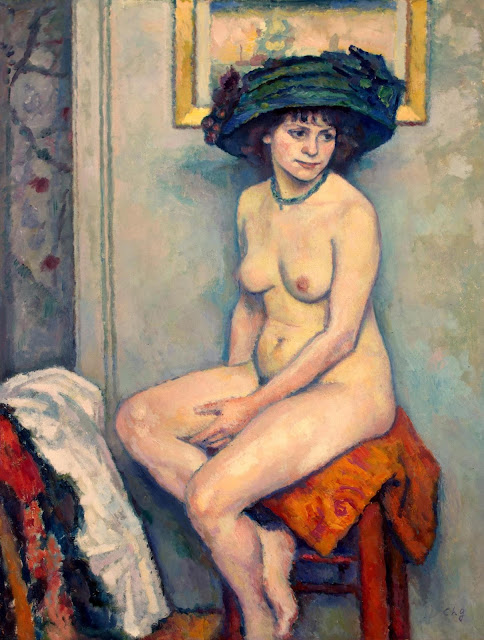 |
| Georges Dupuis Notre Dame Embankment, Le Havre 1908 oil on canvas Hermitage, Saint Petersburg |
 |
| Paul Cézanne Blue Landscape ca. 1904-06 oil on canvas Hermitage, Saint Petersburg |
 |
| Claude Monet Waterloo Bridge, Effect of Fog 1903 oil on canvas Hermitage, Saint Petersburg |
"Besides this same Harmoge, which draweth different colours into one by an orderly and pleasant confusion, it is furthermore requisite that an Artist should take special care about the extreame or uttermost lines; seeing it was ever held one of the greatest excellencies in these Arts that the unrestrained extremities* of the figures resembled in the worke should be drawne so lightly and so sweetly as to represent unto us things we doe not see: neither can it be otherwise but our eye will alwayes beleeve that behind the figures there is something more to be seene than it seeth, when the lineaments that doe circumscribe, compasse, or include the image are so thinne and fine as to vanish by little and little, and to conveigh themselves quite away out of our sight."
– from Book Three (chapter three) of The Painting of the Ancients by Franciscus Junius, first published in English in 1638 – edited by Keith Aldrich, Philipp Fehl and Raina Fel for University of California Press, 1991
* "Unrestrained extremities" (indeterminatos terminos) = indistinct outlines. Junius speaks of two methods of achieving this effect: by lines becoming ever finer until they approach "neere to the subtiltie of the imaginarie Geometricall lines" and by a clever blending of colors which suggests a gentle recession into the background. Instead of enclosing images with sharply drawn outlines, artists define their images by colors that model the objects, blending them in such a way that the object's color, which is weaker where it is further away, and the shadow resulting from its shape are unobtrusively and cleverly combined, giving the effect of depth. He also hints here at one of the most engaging charms of traditional pictorial art, namely, that painting allows the viewers to imagine that in the space created by the artist they could, if they wished, also move to see and touch the figures from behind, and even find there other objects obscured by those they do in fact see. In his Latin text, Junius also quotes from a fragment of the Pythagorean Theages that likens this subtle merging to certain functions of the soul.
 |
| Charles Guérin Nude Model ca. 1910 oil on canvas Hermitage, Saint Petersburg |
 |
| Felice Carena Roman Landscape 1907 oil on panel Hermitage, Saint Petersburg |
 |
| Maurice Lobre Dauphin's Salon at Versailles 1901 oil on canvas Hermitage, Saint Petersburg |
 |
| Jean Jovenau Still-life with Mirror 1912 oil on canvas Hermitage, Saint Petersburg |
 |
| Wassily Kandinsky Landscape 1913 oil on canvas Hermitage, Saint Petersburg |
 |
| Pablo Picasso Nude Youth 1906 gouache on cardboard Hermitage, Saint Petersburg |
 |
| Henri Matisse Game of Bowls 1908 oil on canvas Hermitage, Saint Petersburg |
 |
| Maurice Denis Sacred Spring at Guidel ca. 1905 oil on cardboard Hermitage, Saint Petersburg |
 |
| Joaquín Sorolla Hall of the Ambassadors, Alhambra, Granada 1909 oil on canvas Getty Museum, Los Angeles |
 |
| Jean Puy Landscape 1903 oil on canvas Hermitage, Saint Petersburg |
 |
| Henri Rousseau Monument to Chopin, Luxembourg Gardens, Paris 1909 oil on canvas Hermitage, Saint Petersburg |
"Long garments are odious in a little bodie," sayth Symmachus. "That garment is decently put on, which doth not sweep the dust, and is not trampled upon for hanging too much upon the ground."